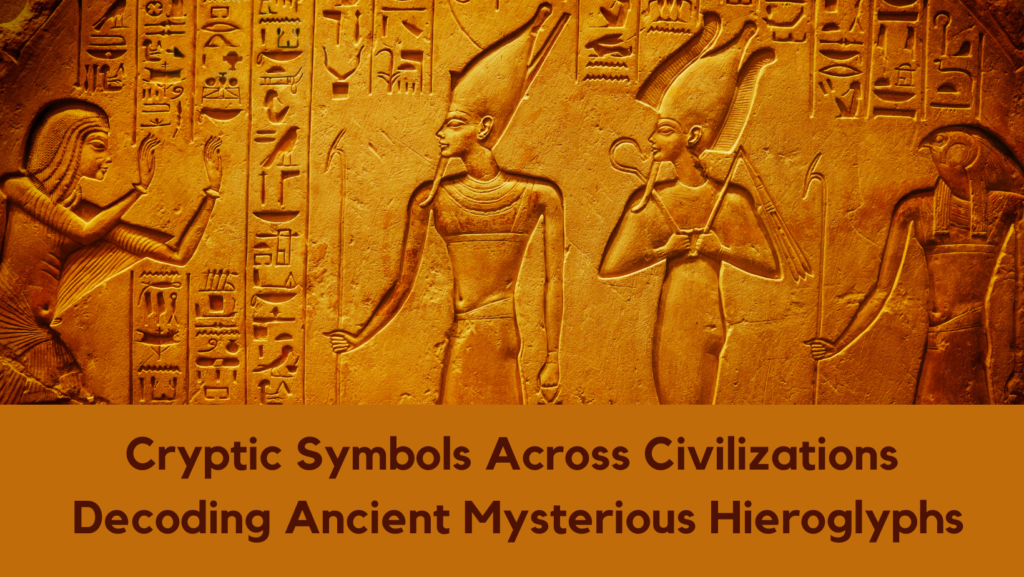Introduction
The lure of ancient hieroglyphs is a call to unravel the enigmatic threads of history that connect us to distant civilizations. These cryptic symbols, etched in the stones and artifacts of ancient empires, aren’t mere relics; they are gateways to understanding the beliefs, values, and stories of our ancestors. What is it that draws us to these pictorial puzzles and the tantalizing prospect of deciphering their secrets? In this extensive exploration, we venture into the world of ancient hieroglyphs, where each stroke tells a tale waiting to be heard.
Understanding Ancient Hieroglyphs
Before we set out on our decoding quest, it’s imperative to grasp the essence of hieroglyphs. They were the earliest form of writing, a pictorial script used by ancient civilizations to record information. From the intricate symbols of the Egyptians to the bold imagery of the Mayans, hieroglyphs varied in appearance and application but shared a common thread of visually descriptive language. They were employed in monumental inscriptions, sacred texts, and even mundane day-to-day communications, manifesting the depths of daily life within those cultures.
A Comparison of Civilizations
The visual language of ancient hieroglyphs was not limited to a single cultural domain. Instead, it flourished uniquely in various great civilizations, with each society imprinting its values and characteristics into the script. The detailed precision of Egyptian hieroglyphs reflected a sophisticated society with advanced institutions and religious convictions. Meanwhile, the Mayan glyphs, with their geometric complexity, hinted at a mathematical and astronomical prowess that was ahead of its time.
Common Themes and Symbols
Despite the geography and epoch that separated these civilizations, core themes and symbols emerged as common threads. The sun, an omnipresent deity, graced the depictions of many cultures, often shown in the jagged rays that extend from its spherical form. Snakes, birds, and other animals, too, made recurring appearances, representing a tapestry of beliefs and cosmologies that echoed across civilizations.
Decoding Techniques
Deciphering hieroglyphs is no small feat. It’s not a language that yields its meaning easily, especially after millennia of silence. The process of decoding involves a blend of scholarly rigor and creative thinking, akin to a linguistic jigsaw puzzle. Here, we explore the methods employed by philologists and archeologists to unlock the meanings encoded in these symbols.
The Rosetta Stone and Beyond
The discovery of the Rosetta Stone – a decree in three scripts, including hieroglyphics, demotic script, and ancient Greek – was a turning point in Egyptology. It provided a key for modern scholars, offering the opportunity to cross-reference translations from known languages to enigmatic hieroglyphics. Yet, it was only the beginning, as discoveries continue to expand our understanding of the ancient written world.
Context Is King
One of the paramount principles of decoding hieroglyphs is the importance of context. The meaning behind a symbol might vary significantly based on its position in a sentence, its accompanying symbols, and the cultural norms of the society that used it. This contextual sensitivity is crucial in avoiding misinterpretations that could warp historical narratives.
Symbolism and Meanings
Hieroglyphs were more than mere words; they were visual metaphors that imbued the written word with a more profound significance. Here, we peel back the layers of meaning in some of the most iconic hieroglyphs and their potential interpretations.
The Eye of Horus
A compelling example is the Eye of Horus, a symbol of protection imbued with mathematical significance, often used to make medical prescriptions. The six parts of this fragmented eye correspond to the senses and elements, illustrating unity in diversity and the interconnectedness of life.
The Mayan “Tzolk’in”
Mayan glyphs defied simplicity with their elaborateness, each character akin to a tale in itself. The ‘Tzolk’in,’ a 260-day calendar, combined day signs and numbers, suggesting a complex system of time-keeping manifest in both their religious ceremonies and daily life.
Impacts on Modern Understanding
The influence of ancient hieroglyphs extends far beyond the skyscrapers of temples and the pages of codices into our modern world. They continue to inspire and inform contemporary art, language, and culture, serving as a bridge of continuity between ancient traditions and our present-day practices.
Hieroglyphs in Pop Culture
From Indiana Jones adventures to blockbuster movies, ancient hieroglyphs captivate the imagination and fuel the storytelling engines of modern entertainment. Their presence in video games, music, and art underscores their pop culture significance, where they are often simplified yet remain an integral part of the mystique surrounding ancient civilizations.
Hieroglyphs in Modern Languages
The impact of hieroglyphs is not merely decorative but linguistically profound. Their influence reverberates through modern languages, such as the Japanese writing system of Kanji, which derives from ancient Chinese characters. The survival of these pictorial scripts reminds us of the resilience of the written word and its ability to endure and evolve across time and space.
Conclusion
The enduring fascination with ancient hieroglyphs lies in the stories they whisper from the past, stories that are as complex and varied as the civilizations that created them. They are an invitation to step into the shoes of our forebears, to see the world through their eyes, and to celebrate the ingenuity of human expression. The cryptic symbols serve as a poignant reminder of our shared heritage and the mysteries that still beckon across the annals of time. It is a call to scholars, enthusiasts, and curious minds to continue the quest of deciphering, understanding, and appreciating the legacy written in stone. In the end, as we decode these hieroglyphic riddles, we part the veils of the past and bring to light the narratives that have shaped the human endeavor.
